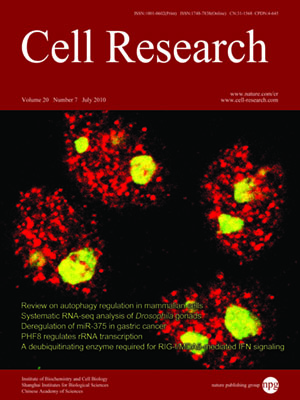
Volume 20, No 7, Jul 2010
ISSN: 1001-0602
EISSN: 1748-7838 2018
impact factor 17.848*
(Clarivate Analytics, 2019)
Volume 20 Issue 7, July 2010: 812-825
ORIGINAL ARTICLES
The molecular cell death machinery in the simple cnidarian Hydra includes an expanded caspase family and pro- and anti-apoptotic Bcl-2 proteins
Margherita Lasi1, Barbara Pauly1, Nikola Schmidt1, Mihai Cikala1, Beate Stiening1, Tina Käsbauer1, Gerhardt Zenner1, Tanja Popp1, Anita Wagner1, Regina T Knapp1, Andreas H Huber1, Michaela Grunert1, Johannes Söding2, Charles N David1 and Angelika Böttger1
1Department Biology II, Ludwig-Maximilians University M黱chen, Gro遠aderner Str. 2, 82152 Planegg-Martinsried, Germany
2Gene Centre; Feodor-Lynen-Str. 25, 81377 M黱chen, Germany
Correspondence: Angelika Böttger,(boettger@zi.biologie.uni-muenchen.de)
The fresh water polyp Hydra belongs to the phylum Cnidaria, which diverged from the metazoan lineage before the appearance of bilaterians. In order to understand the evolution of apoptosis in metazoans, we have begun to elucidate the molecular cell death machinery in this model organism. Based on ESTs and the whole Hydra genome assembly, we have identified 15 caspases. We show that one is activated during apoptosis, four have characteristics of initiator caspases with N-terminal DED, CARD or DD domain and two undergo autoprocessing in vitro. In addition, we describe seven Bcl-2-like and two Bak-like proteins. For most of the Bcl-2 family proteins, we have observed mitochondrial localization. When expressed in mammalian cells, HyBak-like 1 and 2 strongly induced apoptosis. Six of the Bcl-2 family members inhibited apoptosis induced by camptothecin in mammalian cells with HyBcl-2-like 4 showing an especially strong protective effect. This protein also interacted with HyBak-like 1 in a yeast two-hybrid assay. Mutation of the conserved leucine in its BH3 domain abolished both the interaction with HyBak-like 1 and the anti-apoptotic effect. Moreover, we describe novel Hydra BH-3-only proteins. One of these interacted with Bcl-2-like 4 and induced apoptosis in mammalian cells. Our data indicate that the evolution of a complex network for cell death regulation arose at the earliest and simplest level of multicellular organization, where it exhibited a substantially higher level of complexity than in the protostome model organisms Caenorhabditis and Drosophila.
Cell Research (2010) 20:812-825. doi: 10.1038/cr.2010.66; published online 18 May 2010
FULL TEXT | PDF
Browse 2380


